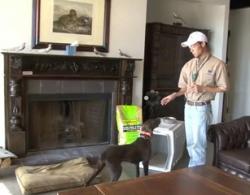How to crate-train your hunting dog

DOGS -- The portable dog crates hunters use to transport their canine companions to the field also are excellent tools for house-breaking pups and new dogs and quickly bringing them into the family -- so you can get a full night's sleep!
The following training tip, courtesy of the Outdoor Wire, is by pro trainer Ethan Pippitt of Willow Creek Kennels in Little Falls, Minn.
Some dog owners view crate training as unnecessary, too difficult or time consuming to try, or even unnatural for the dog.
But Pippitt says a look back to the origin of dogs suggests that crate training is as natural as it gets.
Read on for the details and the step-by-step process.
Looking at the origin of dogs, we find that they are the domesticated form of the gray wolf. Over a time period of approximately 15,000 years dogs were domesticated and developed into hundreds of breeds designed for many specific tasks. Taking into consideration that domestic dogs were originally derived from wolves we can assume that some wolf habits will come naturally to the domesticated dogs of today.
Naturally wolves are den animals and like enclosed safe environments. Our dog's kennel is their den and should be a safe place that is their own within our house. Providing this for our dog, starting at a young age, is not only good for us but also our dog. Having a crate or "den" for your dog will give him a safe place of his own as well as give you the ability to know where he is and what he is doing to prevent unwanted accidents, especially with puppies. With a little history behind why crate training is natural for a dog we can look at the proper way to crate train.
First, you need to start your dog in a crate that is the right size. Your crate should give the dog enough room to stand up, turn around, and lay down without hitting their head on the top. However, the crate should not provide enough room to allow the dog to sleep on one side and defecate on the other. Dogs are clean animals and do not want to "go" where they lie. The correct size of crate allows you to prevent unwanted crate accidents.
Once you have the right size crate, it is important to keep it close to an outside door so that your dog has a quick route outside. Consistency is key; outside is the first place the dog should go when leaving the crate. You will be able to increase the time your dog stays in the crate gradually until your dog is able to hold its bladder at least eight hours or an average night's sleep. Also, making outside the first stop will condition your dog to this process, which leads right into house training.
After your dog has gained some bladder control and is conditioned to relieve himself first thing after leaving the crate or "den", you will be able to allow your dog in the house knowing when he last went to the bathroom. Begin this introduction to the house gradually starting with 30 minutes in the house then back in the crate. You can wait 15 minutes or so, then allow your dog again to go outside to relieve himself. You will be able to increase the time in the house always knowing when the last time your dog emptied his bladder. Soon your dog will be fully house trained and will never learn that wetting in the house is even an option.
Next option: Having a solid crate training foundation will help when you start to teach the cue kennel. This process can be viewed in our recent video showing how to teach "Kennel". The video includes how we recommend using DT Systems H20 1820 to vibrate condition your dog to kennel. Check out this video at www.willowcreekkennels.net.
